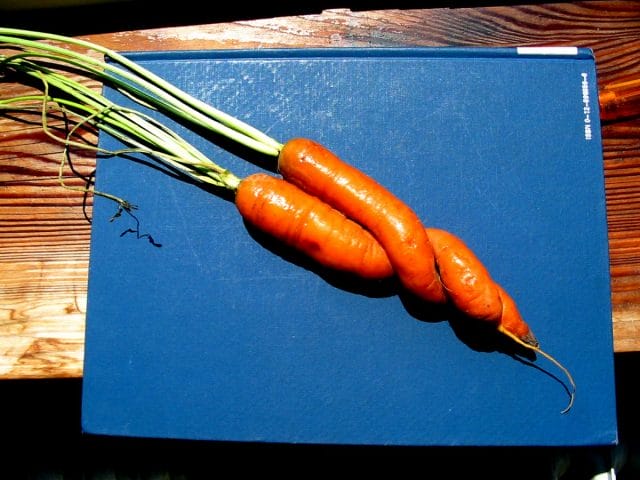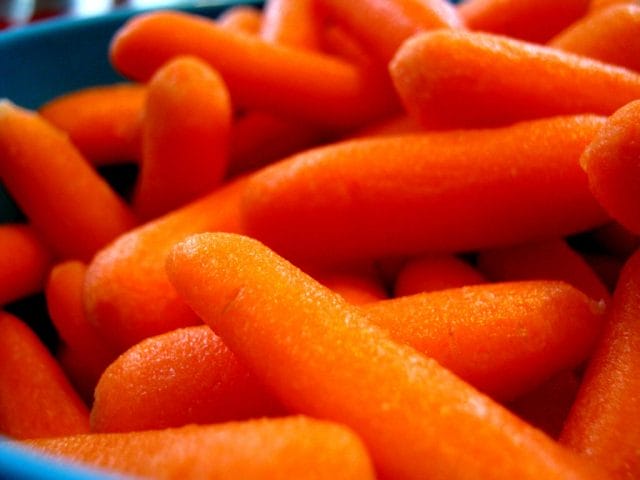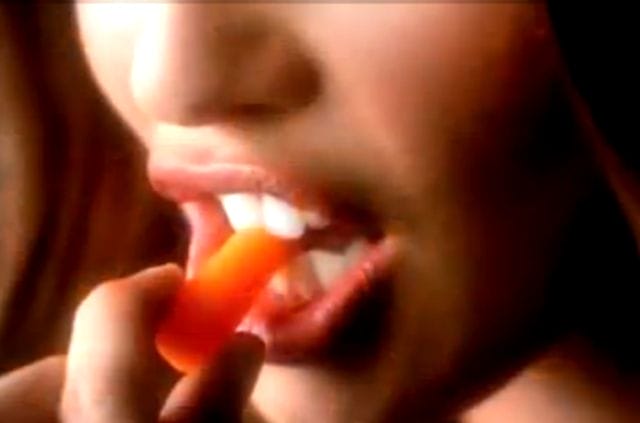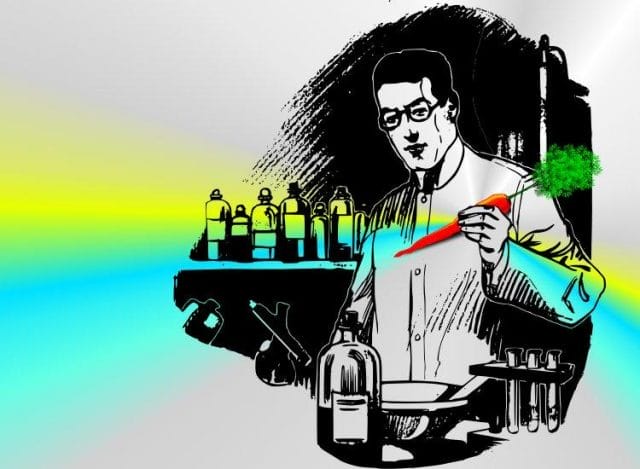The year is 1986, and you operate one of the largest carrot farms and processing plants in California. The weather is beautiful, your farm is vast, and business is good. Life is perfect except for one thing: every day, you need to throw out tons of the vegetables you worked so hard to grow, because they just aren’t pretty enough to sell.
Up to 400 tons of them, actually — up to 70% of each haul. That’s multiple blue whales’ weight in carrots, every single day. This is the position carrot farmer and producer Mike Yurosek found himself in.
It wasn’t that he was a poor farmer: most of that cull were perfectly nutritious, edible carrots. They were just too ugly by supermarket standards, so he couldn’t sell them. That really got to him, in fact it got to him enough that he came up with a solution much more revolutionary than even he realized — he could whittle the ugly full-sized carrots down into pretty, cute, small ones. In other words, Mike Yurosek invented the baby carrot, and carrots have never been the same.
Literal Tons of Waste

While adorable, these amorous carrots would never make it under the cruel glare of supermarket fluorescents
Today, the supermarket produce section is a highly curated window into the American farm — the towering pile of onions has made it through a rigorous and somewhat questionable battery of selection criteria. As former farmer, and PhD student Anna Lee wrote for the Washington Post:
“Some criteria are rightly based on food-safety and shelf-life considerations, but many are manifestations of misguided normative ideas about what produce should look like. Cucumbers should be straight, cauliflower florets should be tightly held, and rhubarb stalks should be ruby red. If not, retailers tell farmers, consumers won’t buy them.”
It’s been like that for quite a while, basically as long as we’ve had supermarkets.
Mike Yurosek started selling his Bunny-Luv carrots packaged in branded plastic bags in the 1960s. On the one hand, packaging his produce let him build a brand, and establish a relationship with consumers who would never come close to seeing his farm. On the other hand, it meant he could only sell carrots that would fit in the bag, and would make the brand look good. Any carrot too long, or too lumpy, or too short, or discolored, or entwined with another carrot, had to be thrown away.
As the Post’s farmer Lee writes of the heartbreak of culling:
“Farmers recognize that they’re at the whim of nature, and they plan accordingly, sowing extra seed with the assumption that pests, diseases or weather will take out some of the crop. That’s part of life. But when plants survive all of that, only to be rejected because they happen to be too small, a little twisted or not quite evenly colored, the loss is harder to face. My heart broke a little as I wheeled barrows of unmarketable onions that had grown long and skinny instead of short and round to the compost pile […] [This] was not the future we’d planned for our seedlings.”
Yurosek tried to be resourceful. He used some of his cull as animal slop, but his farm was so big and he had so much waste — 400 tons a day — that his pigs’ fat turned orange. He went on this way for decades, enduring the daily tragedy of the cull, and dreaming of a better world.
Baby Carrots Beta

Baby carrots: “Los otros Cheetos”
Then, in 1986, he had an idea. Frozen food processors chopped up their vegetables, including carrots, before freezing them. Pea-sized carrot cubes tossed in with peas. Crinkly-cut carrot coins. This was partially because a solid frozen carrot is a pretty inconvenient item — it would take forever to thaw. But Yurosek also realized this meant frozen food processors got away with using irregular produce. “If they can do that,” he thought, “Why can’t we, and pack ’em fresh?”
He got to work prototyping. The first batch he tossed into an industrial potato peeler, and then sliced up by hand. When a local frozen foods processor was going out of business, he got a deal on their old green bean cutter, which was made to clip green beans down into smaller pieces. He found that one of the most aesthetic cuts was to put them through the green bean cutter first, and then through the potato peeler. The result was a 2-inch, skin-free, slightly rounded stub of carrot — a close cousin to the baby carrot of today. (Baby carrots are also sometimes called “baby cut carrots” in order to distinguish them from carrots that are literally immature or naturally dwarf.)
Then he sent a batch of the babies off to his best customer, a supermarket in Los Angeles. From a USA Today interview with Yurosek:
“I said, ‘I’m sending you some carrots to see what you think.’ Next day they called and said, ‘We only want those.'”
Thus, the baby carrot was born.
The Orange Juggernaut

Still from a Bolthouse baby carrots ad
Supermarkets loved baby carrots because they sold like crazy. Bright, clean, regular and snack-sized, they were even more supermarket marketable than the prettiest whole carrots — which, for all the culling they survived, still looked like something that came out of the ground. In the 1980s, a supermarket could by a pound of whole carrots for 10 cents, and sell it for 17. A pound of baby carrots cost them 50 cents, but they could sell it for a dollar — taking the product from a 70% mark-up to a 100% mark-up.
Yurosek prospered, but didn’t try to trademark or patent his process, so other farms started copying him. Baby carrots quickly went from being a way to save imperfect carrots to a perfectable product in their own right. Baby carrots have their own specialized processing machinery now, for one — no more second-hand green bean cutters and potato peelers. The carrots that become todays baby carrots are longer than most (you can get more cuts out of them), and sweeter and juicier.
Part of this is because baby carrots are about as branded as it gets, in the produce world. Shoppers remember when they get a particularly good or particularly bad bag of baby carrots, and if they get a bad one, they avoid the brand in the future.
Driving all of this was the fact that baby carrots were making a whole new market. “The really big deal, the thing that nobody expected,” FastCompany Magazine wrote, “was that baby carrots seemed to make Americans eat more carrots.” People weren’t just eating baby carrots instead of whole carrots, they were eating baby carrots instead of, or in addition, to other things too. Within a decade of baby carrots’ invention, national carrot consumption doubled.
***
Grimmway and Bolthouse are the two biggest carrot producers in the world, and they’re the ones carrying the baby carrot into the 21st Century. In 2010, Bolthouse experimented with an “Eat Them Like Junkfood” marketing campaign, intended to grow the baby carrot market even farther. Baby carrots popped up in vending machines. A @babycarrots Twitter handle started blasting slogans like, “”Yo, @skittles. Taste our rainbow. Of orange.” And spot ads, featuring harebrained stunts, beautiful women, shouting, and explosions, graced prime time television:
We’ll never know what the baby carrot’s inventor would have thought of the campaign. Yurosek, who sold Bunny-Luv to Grimmway Farms in the 1990s, passed away in 2005. A year before his death, USA Today profiled him, painting a portrait of the greatest carrot innovator of the 20th Century, happily retired:
“He spends his days going sport fishing with his grandkids and trying to persuade his wife to make his favorite carrot recipe: her Bunny-Luv carrot cake.
‘When you’ve done something you’re proud of and it’s been acknowledged, it’s a dream come true.'”
This post was written by Rosie Cima; you can follow her on Twitter here. To get occasional notifications when we write blog posts, please sign up for our email list




